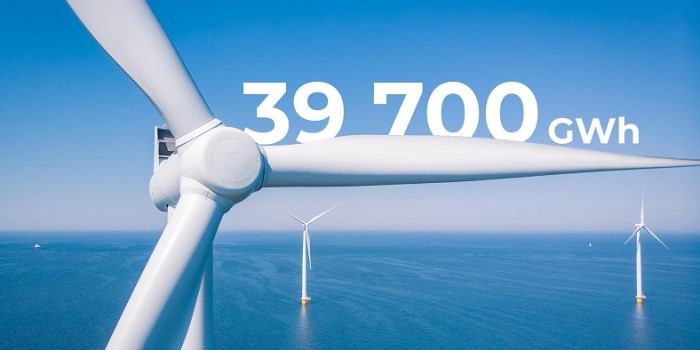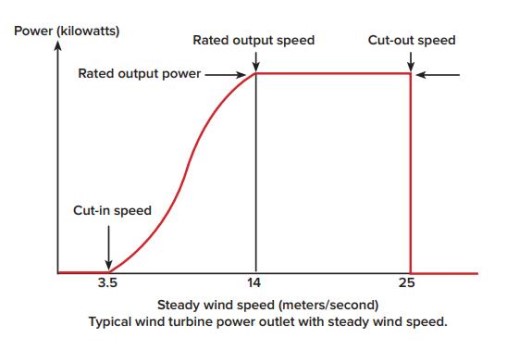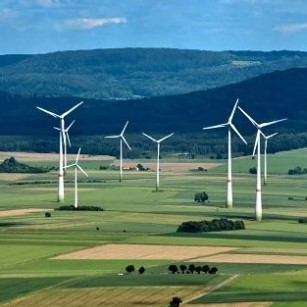Basics of Wind Energy Production
In the United States, most wind energy is commercially generated for delivery and sale on the grid. Wind projects vary in size, configuration, and generating capacity depending on factors such as the wind resource, project area, land-use restrictions, and turbine size. Large wind turbines are most commonly deployed in large groups or rows to optimize exposure to prevailing winds. They may also be installed as a single turbine or with just a few others connected directly to a distribution line.
Because wind is a variable resource with changing speeds, power production levels can vary. The energy output of a facility can be measured over time, however, and expected yearly electricity production can be estimated. While turbines generate power, all other components of a wind plant aid in the transfer of that power to the grid.

Nameplate Capacity
The nameplate capacity (or rated capacity) of a wind turbine is the amount of energy the turbine would produce if it ran 100% of the time at optimal wind speeds. Wind turbines range in nameplate capacity from less than 1 megawatt (MW) to more than 3 MW.
Capacity Factor
To compare output across different generating facilities, capacity factor is used as a measure of the actual energy produced over a specified period of time, divided by the nameplate capacity. In other words, while wind turbines typically generate electricity during most hours of the day, they produce a varying percentage of the nameplate capacity in any given hour. Capacity factor represents the average generation over time. Capacity factors of wind plants may vary from 20% to 50% depending on the turbine type, location, and wind regime (see Power Curve).
Capacity factor can also be used to estimate the expected electricity production of a wind farm, by multiplying nameplate capacity times 8,760 (the number of hours in a year) times capacity factor.
Power Curve
Power production from a wind turbine is a function of wind speed. The relationship between wind speed and power is defined by a power curve, which is unique to each turbine model and, in some cases, unique to site-specific settings. The figure below illustrates a typical wind turbine power curve. Wind speeds are listed on the horizontal axis, in miles per hour (mph) or meters per second (m/s). The turbine’s power output is along the vertical axis in kilowatts (kW).

The cut-in speed, at the lower end of the curve, is the threshold that the hub-height wind speed must reach for the turbine to begin generating electricity. In general, wind turbines begin to produce power at wind speeds of about 6.7 mph (3 m/s). A turbine will achieve its nominal, or rated, power at approximately 26 mph to 30 mph (12 m/s to 13 m/s); this value is often used to describe the turbine’s generating capacity (or nameplate capacity). The turbine will reach its cut-out speed at approximately 55 mph (25 m/s). When wind speeds exceed this, the turbine will stop power production to protect itself from potentially damaging speeds. Variability in the wind resource results in the turbine operating at changing power levels. At good wind energy sites, this variability results in the turbine operating at approximately 35% to 40% of its total possible capacity over a year.
Trends in nameplate capacity and hub height
Over time, increasingly taller towers and longer blade lengths have helped wind turbines achieve economies of scale and higher capacity factors. Most new projects in the U.S. use turbines with a nameplate capacity between 1.7 MW and 2.3 MW—more than twice the size of the average turbine capacity in 2000. At the same time, rotor diameters have nearly doubled, averaging close to 100 m. Hub heights have increased as well, ranging between 80 m and 110 m today versus 50 m to 70 m in 2000. The use of taller towers is driven by two factors: the accommodation of larger rotors, and the desire to tap stronger winds. In general, every 10 m increase in tower height means wind speeds that are 2% to 3% stronger, yielding 3% to 5% more energy.
Because wind is a variable resource with changing speeds, power production levels can vary. The energy output of a facility can be measured over time, however, and expected yearly electricity production can be estimated. While turbines generate power, all other components of a wind plant aid in the transfer of that power to the grid.

Nameplate Capacity
The nameplate capacity (or rated capacity) of a wind turbine is the amount of energy the turbine would produce if it ran 100% of the time at optimal wind speeds. Wind turbines range in nameplate capacity from less than 1 megawatt (MW) to more than 3 MW.
Capacity Factor
To compare output across different generating facilities, capacity factor is used as a measure of the actual energy produced over a specified period of time, divided by the nameplate capacity. In other words, while wind turbines typically generate electricity during most hours of the day, they produce a varying percentage of the nameplate capacity in any given hour. Capacity factor represents the average generation over time. Capacity factors of wind plants may vary from 20% to 50% depending on the turbine type, location, and wind regime (see Power Curve).
Capacity factor can also be used to estimate the expected electricity production of a wind farm, by multiplying nameplate capacity times 8,760 (the number of hours in a year) times capacity factor.
For example:
100 MW total nameplate capacity x 8,760 hours x 35% capacity factor = 306,600 MWh expected annual generation
Power Curve
Power production from a wind turbine is a function of wind speed. The relationship between wind speed and power is defined by a power curve, which is unique to each turbine model and, in some cases, unique to site-specific settings. The figure below illustrates a typical wind turbine power curve. Wind speeds are listed on the horizontal axis, in miles per hour (mph) or meters per second (m/s). The turbine’s power output is along the vertical axis in kilowatts (kW).

The cut-in speed, at the lower end of the curve, is the threshold that the hub-height wind speed must reach for the turbine to begin generating electricity. In general, wind turbines begin to produce power at wind speeds of about 6.7 mph (3 m/s). A turbine will achieve its nominal, or rated, power at approximately 26 mph to 30 mph (12 m/s to 13 m/s); this value is often used to describe the turbine’s generating capacity (or nameplate capacity). The turbine will reach its cut-out speed at approximately 55 mph (25 m/s). When wind speeds exceed this, the turbine will stop power production to protect itself from potentially damaging speeds. Variability in the wind resource results in the turbine operating at changing power levels. At good wind energy sites, this variability results in the turbine operating at approximately 35% to 40% of its total possible capacity over a year.
Trends in nameplate capacity and hub height
Over time, increasingly taller towers and longer blade lengths have helped wind turbines achieve economies of scale and higher capacity factors. Most new projects in the U.S. use turbines with a nameplate capacity between 1.7 MW and 2.3 MW—more than twice the size of the average turbine capacity in 2000. At the same time, rotor diameters have nearly doubled, averaging close to 100 m. Hub heights have increased as well, ranging between 80 m and 110 m today versus 50 m to 70 m in 2000. The use of taller towers is driven by two factors: the accommodation of larger rotors, and the desire to tap stronger winds. In general, every 10 m increase in tower height means wind speeds that are 2% to 3% stronger, yielding 3% to 5% more energy.
Post a Comment:
You may also like:

Featured Articles
What is a Capacity Factor?
 Wind turbines convert the kinetic energy in moving air into rotational energy, which in turn is converted to ...
Wind turbines convert the kinetic energy in moving air into rotational energy, which in turn is converted to ...
 Wind turbines convert the kinetic energy in moving air into rotational energy, which in turn is converted to ...
Wind turbines convert the kinetic energy in moving air into rotational energy, which in turn is converted to ...Basics of Wind Farms
 Throughout history, wind has been used to move grain mills or push the vessels that sailed the seas. However, it was not ...
Throughout history, wind has been used to move grain mills or push the vessels that sailed the seas. However, it was not ...
 Throughout history, wind has been used to move grain mills or push the vessels that sailed the seas. However, it was not ...
Throughout history, wind has been used to move grain mills or push the vessels that sailed the seas. However, it was not ...What is Wind Energy?
 Wind is moving air. We can use the energy in wind to do work. Early Egyptians used the wind to sail ships on the Nile River. ...
Wind is moving air. We can use the energy in wind to do work. Early Egyptians used the wind to sail ships on the Nile River. ...
 Wind is moving air. We can use the energy in wind to do work. Early Egyptians used the wind to sail ships on the Nile River. ...
Wind is moving air. We can use the energy in wind to do work. Early Egyptians used the wind to sail ships on the Nile River. ...Wind Farm Siting, Installation and ...
 Before wind turbines can be installed, the most appropriate location or locations for them needs to be determined. The ...
Before wind turbines can be installed, the most appropriate location or locations for them needs to be determined. The ...
 Before wind turbines can be installed, the most appropriate location or locations for them needs to be determined. The ...
Before wind turbines can be installed, the most appropriate location or locations for them needs to be determined. The ...Basics of Wind Energy Production
 In the United States, most wind energy is commercially generated for delivery and sale on the grid. Wind projects vary in ...
In the United States, most wind energy is commercially generated for delivery and sale on the grid. Wind projects vary in ...
 In the United States, most wind energy is commercially generated for delivery and sale on the grid. Wind projects vary in ...
In the United States, most wind energy is commercially generated for delivery and sale on the grid. Wind projects vary in ...